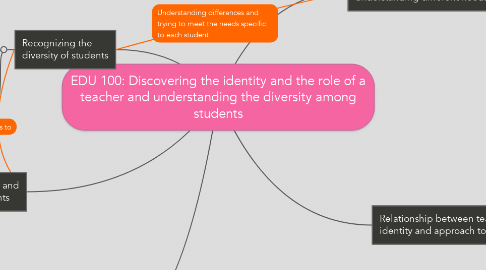
1. Recognizing the diversity of students
1.1. Guest Speaker: Melinda McNie (March 2014) - Learning more about sexual and gender minorities to prevent bullying and creating a safer school environment for all students.
1.1.1. Personal reflection: It is essential to learn and comprehend these different types of representations. It will support students to develop and grow their own identities instead of being forced to behave a certain way that they're not comfortable with. I think it would also be a good idea to educate students about this topic to reduce bullying, because in my opinion, people tend to be more accepting and understanding when they are familiar and are more knowledgeable about the topic.
1.2. Lecture: Race and Racism (March 2014) - The importance of understanding and celebrating the various kinds of diveristy in the classroom
1.2.1. Personal reflection: It is important to make an effort to understand and encourage the different identities of students. This will also give students more freedom and a sense of individuality. As a future teacher, I think it will be important to find a way to celebrate these diversities instead of being "colour blind."
2. Why do we need to know about Aboriginal teachings and residential schools?
2.1. Lecture: Residential Schools and the TRC (April 2014) - The inception of schooling and educational institutions was caused by Europeans coming to Canada and, in an attempt to assimilate them, forced Aboriginal children to attend residential schools.
2.1.1. Personal reflection: I think this is something everyone should know and be aware of. This knowledge will also help with interacting with Aboriginal students and understanding their perspectives.
3. Developing connections and relationships with students
3.1. Personal reflection: I think it is important to become closer to a student in order to instill a better classroom environment. To do this, I think it is important to first understand the student's perspective and their values.
3.1.1. Assignment: Biographical Assignment (January 2014) - By writing the bios, our instructors were able to learn more about each student and helped them learn names and faces more easily.
3.1.2. Guest Speaker: Melinda McNie (March 2014) - One of the ways to prevent bullying that happens to queer students is for the teacher to be accepting of them and to create a safe environment.
4. Inclusive education and understanding different needs
4.1. Lecture: Inclusive Education (March 2014) - The importance of understanding that all students require some kind of special need. Also learning students' strengths and weaknesses and the effectiveness of joining classwork and something of their strength. (Ex. Student incorporating dance with the alphabet and poems to improve their reading skills.)
4.1.1. Personal reflection: I think it is important to recognize that all students have different needs. As an educator, I think I will need to try and make classwork relevant to students' lives and with the current world. This will not only help them develop interest on the topic but it will also be an effective and a memorable way of learning.
4.1.1.1. Reading: Inclusive schooling and gender (2007) - One of the tips that Wallace gives is to use inquiry-based learning and to relate students' interests and learning.
4.2. Video: Ken Robinson (October 2010) - Changing the education paradigm in order to improve the education system and emphasizing divergent thinking instead of oppressing students' creativity.
4.2.1. Personal reflection: Divergent thinking will challenge students to think with more originality. This may allow them to broaden their perspectives and create harmony among themselves, because they would be able to understand others' views better. By being more open-minded and understanding, it may also help them to grow as individuals.
4.2.2. Personal reflection: Instead of teaching students in a traditional manner, I think it would be a good idea to use innovative ways to teach students and nurture their creativity. This correlates with one of my teaching philosophies, Existentialism.
5. Relationship between teaching identity and approach to teaching
5.1. Lecture: Philosophy (January 2014) - Learning the different types of teaching philosophies and identifying which philosophy will reflect our teaching.
5.2. Guest Speaker: Mark Yurick (January 2014) - Teaching identity is essential for educators and directly related to teaching. It is important for individuals to know what their identity is before they begin teaching.
5.2.1. Personal reflection: I somewhat agree with this because while I do think that teaching involves knowing yourself first, I also think that there is opportunity to grow and develop your identity as you teach. I think the initial teaching philosophy can be a rough guideline for where we're heading, but not the absolute end point.
5.3. In-class discussion: The Giving Tree (February 2014) - It was not clear as to what the theme of the story was. One idea that was suggested was that this might be a similar approach to how Cree elders taught children; instead of lecturing them on what is right and what is wrong, they allow them to ponder about the story and learn mainly through experience.
5.3.1. Personal reflection: This relates to one of my educational philosophies, Existentialism. I believe it is important for students to have limited restrictions in educational environments and to come to conclusions based on their own ideas. This is also important for encouraging divergent thinking and to prevent the suppression of creativity.
